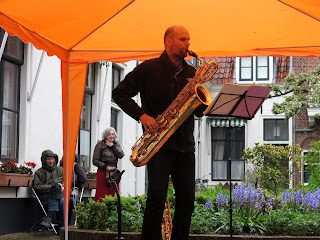Whitsun and
time for the annual concerts in the 35 almshouses Leyden can boast of.
Here is a map of the almshouses I visited.
Although
the almshouses may look like the Beguinages in Belgium, in Holland they were not
built for women who were beguines, religious lay sisters of the Roman Catholic
church not living in a convent. Often the houses were built by rich women and
men who took pity on the poor, on single women and widows, and so provided a
cheap and safe place for them to live. The almshouses were governed by a board
of directors, men and women who decided who could live there and who couldn't, and
who saw to it that the inhabitants strictly observed the rules and regulations.
Although they were not religious institutions, but secular ones, in most cases the
inhabitants had to be members of a protestant church. Many almshouses in Leyden
are now inhabited by students. They are peaceful havens in the middle of a busy
city.
A. Jean
Michelhof, when it was still dry. Young singer, having trouble with her voice because of the damp weather.
For several
years concerts have been organised in the courtyards and enclosed communal gardens
of those almshouses during Whitsun. Two days long it is possible to go from one
almshouse to the next to enjoy music. There is a classical route, a young
talent route, a jazz route, a Spanish route etc. It is very enjoyable to be so
close to the musicians, who are all talented. Some are just building up stage
experience and fresh from the conservatories. On Whitsun itself, the Sunday, we
experienced a few hours of summer and sunshine, from 10 am till 3 pm, a most
welcome relief after this cold spring. I had visitors after church, so we didn't
go into Leyden but enjoyed coffee and drinks in the garden, a first this year.
D. (hidden behind
E on the map) Sint.
Jacobshof (Roman Catholic, see noticeboard below). Typical entrance to an alsmhouse, which was often tucked away and accessible by a long passage behind a heavy wooden door.
On Whit Monday I and a friend went into Leyden to enjoy the concerts and see some
of the almshouses which I am not so familiar with. Unfortunately the weather
had changed completely and it was cold and very wet indeed! Instead of playing
in those lovely gardens, when the rain came down in buckets after a few hours,
the musicians had to take refuge in the covered gateways, amongst the parked
bicycles of the inhabitants.
F. Barent
van Namenhof. Spanish music in a covered bicycle shelter, next to the potplants
G.Bethlehemshof, the lute player in the room for the board of directors.
H.Tevelingshof.The harp tucked away in a corner of the bike shed
Not the romantic surroundings they had dreamt of.
Most of them were very brave, and did not walk away but just continued to play
with frozen fingers, shivering limbs and in draughty porches.
I saw quite
a few almshouses I had not explored before, and I will certainly go back on a
brighter day to have a better look. A saxophone player did his show irrespective
of the weather. He walked around the courtyard, playing his sax, like the pied
piper, under an umbrella held up by his companion, before giving his splendid
recital under a canopy, a bright orange party tent.
D.Sint.
Jacobshof, the sax player, undaunted!
F. Barent
van Namenhof, sheltering under a party tent and umbrella's
When the
festival was over, we were drenched, and tried to warm ourselves with
"bitterballen" and a glass of wine in one of the few bars open on
this special day, before returning home. A hot shower, dry clothes and piping
hot soup were an excellent remedy against the cold.
I. Schachtenhof
Hopefully
next year will be kinder to us, because the festival is a marvellous event and
the choice of music and locations so varied it is impossible to hear and see
everything in just two days.















.JPG)
.JPG)
.JPG)
.JPG)
.JPG)
.JPG)
.JPG)
.JPG)
.JPG)
.JPG)
.JPG)
.JPG)
.JPG)
.JPG)
.JPG)
.JPG)
.JPG)
.JPG)
.JPG)
.JPG)
.JPG)
.JPG)
.JPG)
.JPG)